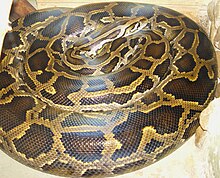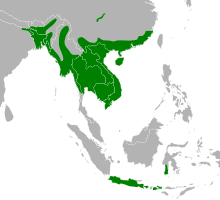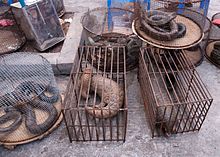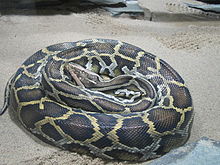Burmese python
| Burmese Python | |
|---|---|

| |
| Scientific classification | |
| Domain: | Eukaryota |
| Kingdom: | Animalia |
| Phylum: | Chordata |
| Class: | Reptilia |
| Order: | Squamata |
| Suborder: | Serpentes |
| Family: | Pythonidae |
| Genus: | Python |
| Species: | P. bivittatus
|
| Binomial name | |
| Python bivittatus (Kuhl, 1820)
| |
| Synonyms | |
The Burmese python (Python bivittatus) is one of the five largest species of snakes in the world (about the third-largest as measured either by length or weight). It is native to a large area of tropical South and Southeast Asia. Until 2009, it was considered a subspecies of Python molurus, but now is recognized as belonging to a distinct species.[3]
They are often found near water and are sometimes semi-aquatic, but can also be found in trees. Wild individuals average 3.7 m (12.1 ft) long,[4][5] but have been known to reach 5.74 m (18.8 ft).[6]
Description
Burmese pythons are dark-colored snakes with many brown blotches bordered in black down the back. The perceived attractiveness of their skin pattern contributes to their popularity with both reptile keepers and the leather industry. The pattern is similar in colour, but different in actual pattern from the African rock python (Python sebae), sometimes resulting in confusion of the two species outside of their natural habitats. The African rock python can generally be distinguished by its tighter pattern of markings, compared to the Burmese python, which has bolder patterns, similar to those seen on a giraffe.[7]
In the wild, Burmese pythons grow to 3.7 m (12 ft 2 in) on average,[4][5] while specimens of more than 4 m (13 ft 1 in) are uncommon.[8][9] This species is sexually dimorphic in size; females average only slightly longer, but are considerably heavier and bulkier than the males. For examples, length-weight comparisons in captive Burmese pythons for individual females have shown: at 3.47 m (11 ft 5 in) length, a specimen weighed 29 kg (64 lb), a specimen of just over 4 m (13 ft 1 in) weighed 36 kg (79 lb), a specimen of 4.5 m (14 ft 9 in) weighed 40 kg (88 lb), and a specimen of 5 m (16 ft 5 in) weighed 75 kg (165 lb). In comparison, length-weight comparisons for males found: a specimen of 2.8 m (9 ft 2 in) weighed 12 kg (26 lb), 2.97 m (9 ft 9 in) weighed 14.5 kg (32 lb), a specimen of 3 m (9 ft 10 in) weighed 7 kg (15 lb), and a specimen of 3.05 m (10 ft 0 in) weighed 18.5 kg (41 lb).[10][11][12][13][14] In general, individuals over 5 m (16 ft 5 in) are rare.[8] The record maximum length for Burmese pythons is held by a female named “Baby”, that lived at Serpent Safari, Gurnee, Illinois, for 27 years. Shortly after death, her actual length was determined to be 5.74 m (18 ft 10 in). Widely published data of specimens that were reported to have been even several feet longer are not verified.[6] Dwarf forms occur on Java, Bali, and Sulawesi. On Bali, they reach an average length of 2 m (6 ft 7 in),[15] and on Sulawesi, they achieve a maximum of 2.5 m (8.2 ft).[16]
Distribution and habitat

Burmese pythons are found throughout Southern and Southeast Asia, including eastern India, Nepal, western Bhutan, southeastern Bangladesh, Myanmar, Thailand, Laos, Cambodia, Vietnam, northern continental Malaysia, far southern China (Fujian, Jiangxi, Guangdong, Hainan, Guangxi, and Yunnan),[17] Hong Kong, and in Indonesia on Java, southern Sulawesi, Bali, and Sumbawa.[18] Burmese pythons are also reported from Kinmen, very close to the Chinese mainland, but in Taiwanese territory;[19] the Burmese python belongs to the fauna of Taiwan when Taiwan refers to the Republic of China, but not to the island of Taiwan.
These pythons are excellent swimmers and need a permanent source of water. They can be found in grasslands, marshes, swamps, rocky foothills, woodlands, river valleys, and jungles with open clearings. They are good climbers and have prehensile tails.
Invasive species (United States)


Python invasion has been particularly extensive, notably across South Florida, where a large number of pythons can now be found in the Florida Everglades.[20] It has been suggested that the current number of Burmese pythons in the Florida everglades has reached a minimum viable population and become an invasive species. Hurricane Andrew in 1992 was deemed responsible for the destruction of a python breeding facility and zoo, and these escaped snakes spread and populated areas into the Everglades.[21] More than 1,330 [22] have been captured in the Everglades.
By 2007, the Burmese python was found in northern Florida, and in the coastal areas of the Florida Panhandle, and the importation of Burmese pythons was banned in the United States in January 2012 by the U.S. Department of the Interior.[23] A 2012 report stated, "in areas where the snakes are well established, foxes and rabbits have disappeared. Sightings of raccoons are down by 99.3%, opossums by 98.9%, and white-tailed deer by 94.1%."[24] Bird and coyote populations may be threatened, as well as the already-rare Florida panther.[24]
Burmese pythons also compete with the native American alligator, and numerous instances of alligators and pythons attacking - and in some cases, preying on - each other have been reported and recorded.
Behavior
Burmese pythons are mainly nocturnal rainforest dwellers.[25] When young, they are equally at home on the ground and in trees, but as they gain girth, they tend to restrict most of their movements to the ground. They are also excellent swimmers, being able to stay submerged for up to half an hour. Burmese pythons spend the majority of their time hidden in the underbrush. In the northern parts of its range, the Indian python may brumate for some months during the cold season in a hollow tree, a hole in the riverbank, or under rocks. Brumation[26] is biologically distinct from hibernation. While the behaviour has similar benefits, specifically to endure the winter without moving, it also involves preparation of both male and female reproductive organs for the upcoming breeding season. Controversy exists over whether the Burmese species is able to brumate.
Burmese pythons breed in the early spring, with females laying clutches of 12–36 eggs in March or April. They remain with the eggs until they hatch, wrapping around them and twitching their muscles in such a way as to raise the ambient temperature around the eggs by several degrees. Once the hatchlings use their egg tooth to cut their way out of their eggs, no further maternal care is given. The newly hatched often remain inside their eggs until they are ready to complete their first shedding of skin, after which they hunt for their first meal.[27]
Diet
Like all snakes, the Burmese python is carnivorous. Its diet consists primarily of appropriately sized birds and mammals. The snake uses its sharp rearward-pointing teeth to seize its prey, then wraps its body around the prey, at the same time contracting its muscles, killing the prey by constriction. It is often found near human habitation due to the presence of rats, mice, and other vermin as a food source. However, its equal affinity for domesticated birds and mammals means it is often treated as a pest. In captivity, its diet consists primarily of commercially available, appropriately sized rats, graduating to larger prey such as rabbits and poultry as it grows. Exceptionally large pythons may even require larger food items such as pigs or goats, and are known to have attacked and eaten alligators and adult deer in Florida, where they are an invasive species.[28][29]
Digestion
The digestive response of Burmese pythons to such large prey has made them a model species for digestive physiology. A fasting python has a reduced stomach volume and acidity, reduced intestinal mass, and a 'normal' heart volume. After ingesting prey, the entire digestive system undergoes a massive remodelling, with rapid hypertrophy of the intestines, production of stomach acid, and a 40% increase in mass of the ventricle of the heart to fuel the digestive process.[30]
Conservation


Wild populations are considered to be "threatened" and are listed on Appendix II of CITES. All the giant pythons (including the Indian python, the African rock python, and the reticulated python) have historically been slaughtered to supply the world leather market, as well as for folk medicines, and captured for the pet trade. Some are also killed for food, particularly in China.
The IUCN has recently listed the Burmese python as "Vulnerable", reflecting its overall population decline. Important reasons for the decline are trade for skins and for food; habitat degradation may be a problem in some upland areas.[1]
In Hong Kong, it is a protected species under Wild Animals Protection Ordinance Cap 170.
Captivity
Burmese pythons are often sold as pets, and are made popular by their attractive colour and apparently easy-going nature. However, these animals have a rapid growth rate, and often exceed 2.1 m (6.9 ft) in length in a year if cared for and fed properly. By age four, they will have reached their adult size, though they continue growing very slowly throughout their lives, which may exceed 20 years.

Although this species has a reputation for docility, they are very powerful animals, capable of inflicting severe bites or even killing a keeper by constriction.[31] They also consume large amounts of food, and due to their size, require large, often custom-built, secure enclosures. As a result, some are released into the wild, and become invasive species that devastate the environment. For this reason, some jurisdictions (including Florida due to the python invasion in the Everglades)[32] have placed restrictions on the keeping of Burmese pythons as pets. Violators could be imprisoned for more than 7 years or fined $500,000 if convicted.
Burmese pythons are opportunistic feeders; they eat almost any time food is offered, and often act hungry even when they have recently eaten. As a result, they are often overfed, causing obesity-related problems to be common in captive Burmese pythons.
Like the much smaller ball python, Burmese pythons are known to be easygoing or timid creatures, which means that if cared for properly, they can easily adjust to living near humans.[citation needed]
Handling

Although pythons are typically afraid of people due to their high stature, and generally avoid humans, special care is still required when handling them. Given their adult strength, multiple handlers (up to one person per meter of snake) are usually recommended.[33] Some jurisdictions require owners to hold special licenses, and as with any wild animal being kept in captivity, treating them with the respect an animal of this size commands is important.[citation needed]
Variations

The Burmese python is frequently captive-bred for colour, pattern, and more recently, size. Its albino form is especially popular and is the most widely available morph. They are white with patterns in butterscotch yellow and burnt orange. Also, "labyrinth" specimens with maze-like patterns, khaki-coloured "green", and "granite" with many small angular spots are available. Breeders have recently begun working with an island lineage of Burmese pythons. Early reports indicate that these "dwarf" Burmese have slightly different colouring and pattern from their mainland relatives and do not grow much over 2.1 m (6.9 ft) in length. One of the most sought-after of these variations is the leucistic Burmese. This particular variety is very rare, being entirely bright white with no pattern and blue eyes, and has only recently (2008/2009) been reproduced in captivity as the homozygous form (referred to as "super" by reptile keepers) of the codominant hypomelanistic trait. The caramel Burmese python has caramel-coloured pattern with "milk-chocolate" eyes.
See also
Footnotes
- ^ a b Stuart, B.; Nguyen, T.Q.; Thy, N.; Grismer, L.; Chan-Ard, T.; Iskandar, D.; Golynsky, E.; Lau, M.W.N. (2012). "Python bivittatus". The IUCN Red List of Threatened Species. 2012. IUCN: e.T193451A2237271. doi:10.2305/IUCN.UK.2012-1.RLTS.T193451A2237271.en. Retrieved 13 January 2018.
{{cite journal}}: Unknown parameter|last-author-amp=ignored (|name-list-style=suggested) (help) - ^ Python bivittatus at the Reptarium.cz Reptile Database
- ^ Jacobs, H.J.; Auliya, M.; Böhme, W. (2009). "On the taxonomy of the Burmese Python, Python molurus bivittatus KUHL, 1820, specifically on the Sulawesi population". Sauria. 31 (3): 5–11.
- ^ a b Smith MA (1943). The Fauna of British India, Ceylon and Burma, Including the Whole of the Indo-Chinese Sub-region. Reptilia and Amphibia. Vol. III.—Serpentes. London: Secretary of State for India. (Taylor and Francis, printers). xii + 583 pp. (Python molurus bivittatus, pp. 108-109).
- ^ a b Campden-Main SM (1970). A Field Guide to the Snakes of South Vietnam. Washington, District of Columbia. pp. 8-9.
- ^ a b Barker DG, Barten SL, Ehrsam JP, Daddono L (2012). "The Corrected Lengths of Two Well-known Giant Pythons and the Establishment of a New Maximum Length Record for Burmese Pythons, Python bivittatus ". Bulletin of the Chicago Herpetological Society 47 (1): 1-6. pdf.
- ^ Comparing Wild Florida Burmese & African Rock Pythons - https://www.youtube.com/watch?v=MosOA408Ye8
- ^ a b Saint Girons H (1972). "Les serpents du Cambodge ". Mémoires du Muséum national d'Histoire naturelle, Série A 40-41. (in French).
- ^ Deuve J (1970). "Serpents du Laos ". Mémoire O.R.S.T.O.M., Paris (39): 61-62, 65-66. (in French).
- ^ Van Mierop, LHS; Barnard, SM (1976). "Observations on the reproduction of Python molurus bivittatus (Reptilia, Serpentes, Boidae)". Journal of Herpetology. 10: 333–340. doi:10.2307/1563071.
- ^ Barker, DG; Murphy, JB; Smith, KW (1979). "Social behavior in a captive group of Indian pythons, Python molurus (Serpentes, Boidae) with formation of a linear social hierarchy". Copeia. 1979: 466–471. doi:10.2307/1443224.
- ^ Marcellini, DL; Peters, A (1982). "Preliminary observations on endogeneous heat production after feeding in Python molurus". Journal of Herpetology. 16: 92–95. doi:10.2307/1563914.
- ^ Jacobson, ER; Homer, B; Adams, W (1991). "Endocarditis and congestive heart failure in a Burmese python (Python molurus bivittatus)". Journal of Zoo and Wildlife Medicine. 22: 245–248.
- ^ Groot, TVM; Bruins, E; Breeuwer, JAJ (2003). "Molecular genetic evidence for parthenogenesis in the Burmese python, Python molurus bivittatus". Heredity. 90 (2): 130–135. doi:10.1038/sj.hdy.6800210.
- ^ McKay JL (2006). A Field Guide to the Amphibians and Reptiles of Bali. Krieger Publishing Company 2006. ISBN 1-57524-190-0. pp. 13, 14, 18, 86.
- ^ de Lang R, Vogel G (2005). The Snakes of Sulawesi: A Field Guide to the Land Snakes of Sulawesi with Identification Keys. Frankfurt Contributions to Natural History Band 25, Edition Chimaira 2005. ISBN 3-930612-85-2. pp. 23-27, 198-201.
- ^ Barker DG, Barker TM (2010). "The Distribution of the Burmese Python, Python bivittatus, in China" (PDF). Bulletin of the Chicago Herpetological Society. 45 (5): 86–88. The authors describe the presence of this specimen in Sichuan as an anomalous occurrence, and do not include the province in the python's range
- ^ Barker DG, Barker TM (2008). "The Distribution of the Burmese Python, Python molurus bivittatus" (PDF). Bulletin of the Chicago Herpetological Society. 43 (3): 33–38.
- ^ Breuer, Hans; Murphy, William Christopher (2009–2010). "Python molurus bivittatus". Snakes of Taiwan. Retrieved 17 October 2012.
- ^ "Top 10 Invasive Species". Time. 2010-02-02. Retrieved 2010-04-27.
- ^ "Democrats Hold Hearing on Administration's Plan to Constrict Snakes in the Everglades - House Committee on Natural Resources". Naturalresources.house.gov. 2010-03-23. Retrieved 2012-08-09.
- ^ http://www.nps.gov/ever/naturescience/burmesepython.htm (US National Park Service website - December 31, 2009)
- ^ U.S. Fish and Wildlife Service. 2012. Salazar announces ban on importation and interstate transportation of four giant snakes that threaten Everglades. U.S. Fish and Wildlife Service Press Release. Jan 17 2012.
- ^ a b Adams, Guy (2012-02-01). "Pythons are squeezing the life out of the Everglades, scientists warn". The Independent. London.
- ^ Evans, Susan (2003). "Python molurus, Burmese Python". The deep Scaly Project. Digital Morphology. Retrieved 2007-07-25.
- ^ Glossary of commonly used terms
- ^ Ghosh, Anwiksha. "Burmese Python". AnimalSpot.net. Retrieved 27 December 2012.
- ^ National Geographic: Python Bursts After Eating Gator
- ^ "Large Python Captured, Killed After Devouring Adult Deer | KSEE 24 News - Central Valley's News Station: Fresno-Visalia - News, Sports, Weather | Local News". Ksee24.com. 2011-10-31. Archived from the original on 2012-07-31. Retrieved 2012-08-09.
{{cite web}}: Unknown parameter|deadurl=ignored (|url-status=suggested) (help) - ^ "Digestive physiology of the Burmese python: broad regulation of integrated performance". Jeb.biologists.org. 2008-12-15. Retrieved 2012-08-09.
- ^ Thirteen Foot Burmese Python Kills Owner
- ^ Burrage, Gregg (2010-06-30). "New law makes Burmese python illegal in Florida". Abcactionnews.com. Archived from the original on 2013-05-01. Retrieved 2012-08-09.
{{cite news}}: Unknown parameter|deadurl=ignored (|url-status=suggested) (help) - ^ "Playing with the Big Boys: Handling Large Constrictors". www.anapsid.org. Retrieved 2017-09-08.
References
- Mattison, Chris (1999). Snake. DK Publishing. ISBN 0-7894-4660-X.
- Anapsid.org: Burmese Python
Further reading
- Bryan Christy: The Lizard King: The True Crimes and Passions of the World's Greatest Reptile Smugglers. New York: TWELVE, 2008 ISBN 978-0-446-58095-3
External links
- IUCN Red List vulnerable species
- Pythonidae by common name
- Reptiles described in 1820
- Reptiles of Bangladesh
- Reptiles of Myanmar
- Reptiles of Cambodia
- Reptiles of China
- Reptiles of India
- Reptiles of Indonesia
- Reptiles of Laos
- Reptiles of Taiwan
- Reptiles of Thailand
- Reptiles of Vietnam
- Reptiles of the United States
- Wildlife of Yunnan
- Invasive reptile species
- Python

